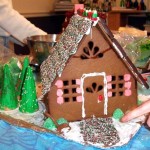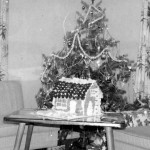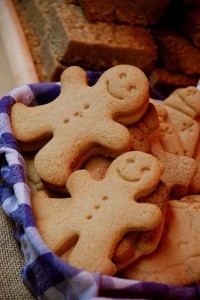by Cat, Sept 2013 (Photo, right, from Wikimedia Commons)
See also: 1. Scandinavian Gingerbread Cake; 2. Gingerbread Cake, with Mustard
As a person of Scandinavian heritage, I can attest that Scandinavians (as well as people from the Germanic countries) have a love affair with ginger. It is used not only in sweat treats like these holiday cookies, but also in preserved meats.
When I was little, Mom made a gingerbread house every year at Christmastime (photo, left). Each year they were more elaborate, decorated with candies and frosting. She set them in a snowy landscape (white frosting), and made gingerbread trees as landscaping for the house. My 1st-grade year, she made one for my class to share; she even made tiny gingerbread boys and girls playing in the ‘snow.’ But our teacher, Miss Reep, thought it was so beautiful that she would not let us eat it. After the holiday Miss Reep put it away in a cupboard, where it turned to mold.
I no longer have Mom’s recipe, but when I was a young adult, I made a version of the recipe for tree ornaments: boys, girls, dogs and cats, then invited friends to a party where we ate most of the ornaments.
I lived in Portland OR for the years of my career. The grand hotel there – the Benson – has a wonderful gingerbread castle sculpture in the lobby every holiday season (made fresh each year). Photo, below, depicts downtown Portland in 1913; gingerbread sculpture by Benson Hotel Chef David Diffendorfer (5).
Gingerbread Cookies
This recipe is adapted from a Betty Crocker Cookbook, 1989 edition, with input from The Art of Fine Baking, by Paula Peck. I just don’t think this would translate well with stevia, so I include all the sugar and molasses of the original. I do, however, prefer to use Rapadura sugar instead of brown sugar, if I plan to eat the cookies. You may also wish to use blackstrap molasses instead of dark molasses for the abundant nutrients, if you plan to eat them.
The original uses all-purpose flour, which is best if you don’t plan to eat the cookies. Otherwise, use part whole wheat and part unbleached white flour as indicated, to maximize nutrition.
Some recipes also include 1 egg, which is beaten into the sugar/butter mix, before adding the water; in this case use only 1/3 cup water. The dough should be stiff, but if it is too dry after adding the flour, add more water 1 tsp at a time. I also advise adding 1 Tbsp lemon juice (or apple cider vinegar) for part of the water volume, as this activates the soda (and lemon juice adds a nice flavor). You can also add 1 tsp lemon zest to the sifted flour (whisk with fork or egg whisk to combine).
If you plan to eat the cookies, you can use a buttercream frosting. But if you want to use them as holiday decorations, I recommend Royal Icing (recipe below), as it dries hard. It is also good for eating.
See also Lebkuchen: Austrian Gingerbread Cookies (6) from Viking River Cruises, and Classic Gingerbread Cookies (7) from by Carolyn Well, FineCooking.com
Makes 2 1/2 dozen cookies. (Photo, below, from Wikimedia Commons)
Ingredients & Equipment for Cookies:
- 1 cup packed brown sugar (or Rapadura sugar)
- 1/3 cup butter or lard
- 1 1/2 cups dark molasses (or blackstrap molasses), or half honey, half molasses
- 1 Tbsp freshly squeezed lemon juice or apple cider vinegar (optional)
- up to 2/3 cup filtered water (see above)
- 1 egg (optional)
- 7 cups all-purpose flour (or 2 cups whole wheat, 5 cups unbleached white flour), plus extra for rolling
- 2 tsp baking soda
- 2 tsp ground ginger
- 1 tsp unrefined sea salt
- 1 tsp ground allspice
- 1 tsp ground cloves
- 1 tsp ground cinnamon
- 1 tsp lemon zest (optional)
- Buttercream frosting or Royal Icing (below), slivers of nuts, dried or candied fruit, or small candies for decoration
- small and large bowls
- cookie sheet(s)
- pastry tube or other device for decorating with frosting/glaze.
Method for Cookies:
- Mix sugar, butter, molasses and water in large bowl. If using vinegar or lemon juice add it with the water.
- Sift flour(s), soda, salt and spices into small bowl. If using lemon zest, whisk it into the sifted flour. Stir flour mixture into first mixture. Cover and chill at least 2 hours (up to 2 days). The dough should be stiff.
- Heat oven to 350. Roll dough 1/8” – 1/4” thick on lightly floured board. (For decoration only, roll thinly. If you want a softer cookie for eating, roll it 1/4” thick). Cut with floured gingerbread cutter. Place 2 inches apart on lightly greased cookie sheet. Shape ideas: boys, girls, stars, hearts, wreaths, reindeer.
- Save the scraps, brushing off excess flour, and knead them into another ball for rolling.
- Bake, one sheet at a time, until no indentation remains when touched, about 10 – 12 minutes. If your oven bakes unevenly, rotate the sheet halfway through the baking time.
- Cool on rack. If you are making these for ornaments, pierce a hole near the top of the cookie while still warm; this is for a ribbon to hang the cookie.
- If you wish to coat with a glaze, do so while the cookies are still warm.
- When fully cooled, decorate as desired.
Royal Icing
This recipe is from Sandra Lee on the Food Network (3) and Gingerbread Cookies 101 (4) by Rick Rodgers.
Ingredients & Equipment for Icing:
- 2 large egg whites
- 2 tsp fresh lemon juice or 1 tsp vanilla extract
- 3 cups confectioners’ sugar (I prefer Rapadura Powdered Sugar, or Make Your Own Unrefined Powdered Sugar), sifted
- Food coloring (optional)
Method for Icing:
- Using a hand mixer in a small bowl, beat egg whites with lemon juice or extract until frothy. Add sifted powdered sugar and beat on low speed until combined, smooth and shiny.
- Then beat on high speed for about 5 minutes until stiff and glossy.
- Add food coloring, if desired, and pipe onto cookies with a pastry bag or paper funnel.
References:
- Betty Crocker Cookbook, 1989 edition
- The Art of Fine Baking, by Paula Peck
- foodnetwork.com/recipes/sandra-lee/gingerbread-cookies-with-royal-icing-recipe/index.html
- foodnetwork.com/recipes/gingerbread-cookies-101-recipe/index.html
- https://www.facebook.com/TheBensonHotel
- vikingrivercruises.com/email/lebkuchen.aspx
- finecooking.com/recipes/classic-gingerbread-cookies.aspx



